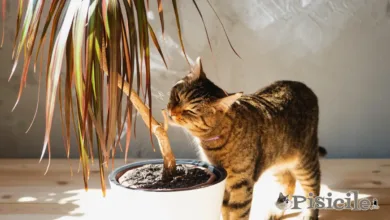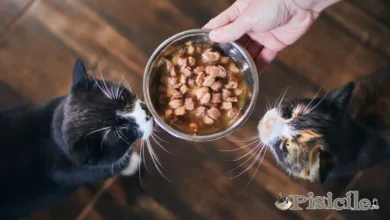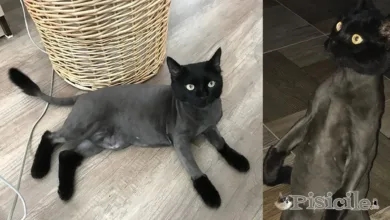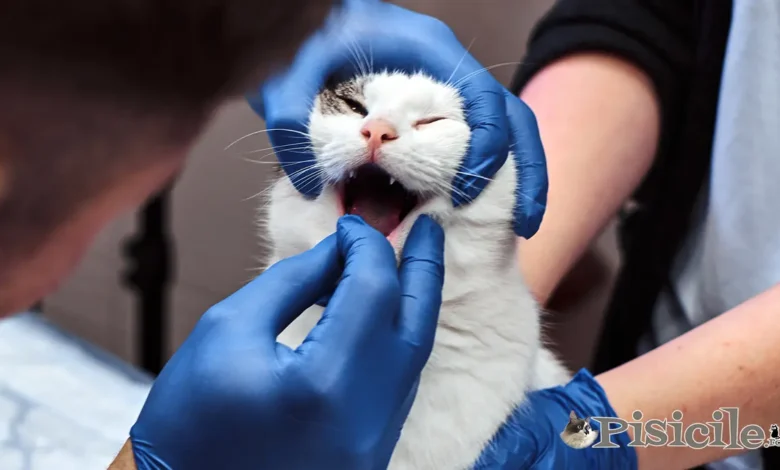
Periodontal disease in cats (periodontitis) is a condition that affects the supporting apparatus of the teeth in the jawbones, including the periodontium. There are two main forms of periodontal disease: gingivitis and periodontitis. Gingivitis is the first stage in the appearance of periodontitis and is caused by the acid secretions and toxins released at the level of the bacterial plaque. These substances have an irritating effect, causing inflammation, which is called gingivitis. When the inflammation evolves into an infection and spreads from the gums to the bone structure of the tooth and to the ligamentous structures, it can be considered the primary stage of periodontitis.
Most of the time, periodontitis occurs after an ignored and untreated gingivitis. Bacterial plaque accumulates on the teeth, irritating the gums, and the periodontal ligament loses collagen, causing destruction of the alveolar bone, which weakens the attachment of the tooth.
Subject
Periodontal disease in cats. Causes, symptoms and treatment.
The main cause of gingivitis and progression to periodontitis is lack of oral hygiene. However, there are other important factors that can trigger periodontal disease in cats.
Causes of parodontosis in cats
In addition to the lack of oral hygiene, the most common causes that can trigger periodontitis in cats are:
Viral infections. Feline Calcivirus (FCV) and Feline Herpes Virus (FHV) can play a significant role in triggering gingivitis, and Feline Leukemia Virus (FeLV) and Feline Immunodeficiency Virus (FIV) affect the cat's immune system, although they are not directly related to gingivitis.
Incorrect alignment of the teeth. An abnormal positioning of the teeth and their crowding favors the accumulation of bacterial plaque.
Genetics. Some cats are genetically predisposed to dental diseases, and in some situations periodontitis can develop even with strict oral hygiene.
Dental resorption. Cavity-like lesions in the cat's mouth lead to gingivitis around the teeth.
Immune diseases. Inflammation of the mucous membrane of the oral cavity can be caused by immunomedial or autoimmune diseases, exaggerated reactions of the immune system to normal stressors such as bacteria and toxins accumulated in the bacterial plaque.
Bacterial plaque. As with gingivitis, plaque build-up on the teeth is a major cause of periodontal disease. Plaque turns into tartar over time and can cause gingival inflammation.
The tartar: Tartar deposits are made up of minerals that come from saliva and build up on the teeth. Tartar can irritate the gums and contribute to periodontal disease.
Bacterial infections: Pathogenic bacteria that accumulate around the teeth can cause severe infection and inflammation of the gums and supporting tissues.
Periodontal disease in cats is a common condition that affects the oral cavity and the supporting tissues of the teeth, therefore maximum attention and urgent consultation with the specialized veterinarian should be given.
Symptoms of periodontal disease in cats
The main symptoms of periodontal disease in cats are:
Bad breath (does not charge). One of the first signs of periodontal disease is bad breath.
Bleeding gums. Gums may bleed while brushing or chewing.
Feeding difficulties. Cats may experience difficulty chewing and swallowing, resulting in decreased appetite and food intake.
Excessive salivation. Profuse salivation can be a sign of oral discomfort.
Pain when chewing. Cats may experience pain while chewing.
Loose teeth or tooth loss. In advanced stages, periodontal disease can lead to tooth loss.
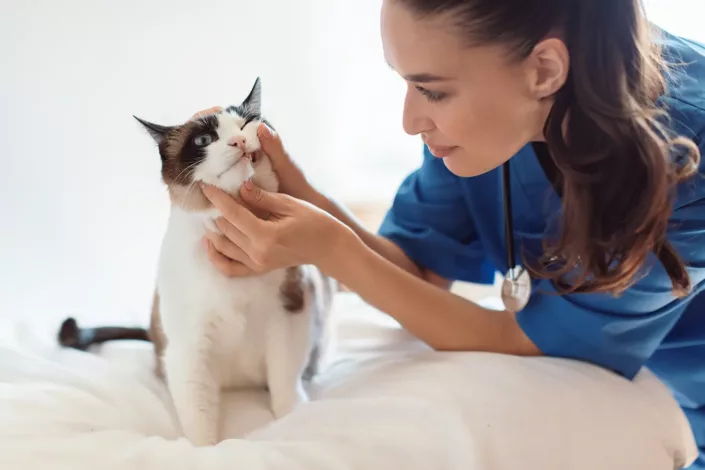
Treatment of periodontitis. Periodontal disease in cats.
It is very important and recommended that the cat be seen by a veterinarian for proper evaluation and treatment planning. Management of periodontal disease in cats requires a careful and ongoing approach to maintain your cat's oral health.
Treatment of periodontal disease in cats varies depending on the stage of the disease. In the case of gingivitis without bone loss, scaling is effective and consists in removing the bacterial plaque from the teeth, including under the gum. These procedures can help manage inflammation and prevent disease progression.
If the loss of the supporting structures of the tooth is found and the process is irreversible, the veterinarian will opt for one of the following solutions.
Application of antibiotics under the gum. To fight local infections and control the spread of bacteria.
Trying to channel. In some cases, root canal treatments can be used to preserve the affected tooth while removing the infection from within.
Dental extractionah. In severe cases, when the teeth are irreparably damaged, they can be extracted to prevent the spread of infection and prevent discomfort.
Treatment with antibiotics. In severe infections, antibiotics may be needed to fight the bacteria and control the inflammation.
Pain management. To ensure the animal's comfort, medications may be administered to manage the pain associated with the procedures or disease state.
Oral hygiene at home. Owners can play a key role in preventing relapses by adopting regular oral hygiene, including brushing and using specific products designed to maintain dental health.
Maintaining rigorous dental hygiene and regular visits to the veterinarian help ensure your pet's optimal oral health.

